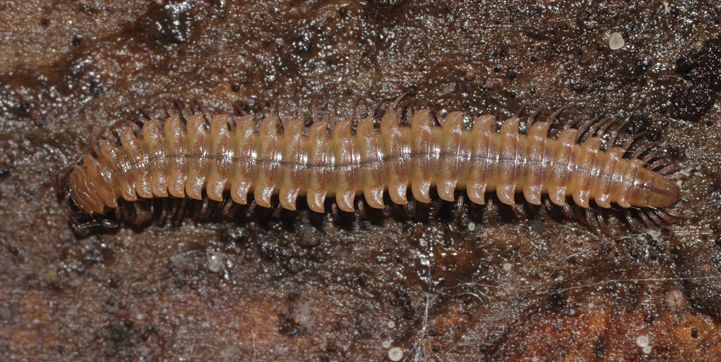|
Metopidiotrichidae
Metopidiotrichidae is a family of millipedes in the order Chordeumatida. These millipedes range from 4 mm to 17 mm in length. Adult millipedes in this family have 32 segments (counting the collum as the first segment and the telson as the last), not the 30 segments usually found in this order. Adult males in this family (e.g., ''Reginaterreuma monroei'', ''R. daviesae'', ''R. unicolor'', ''R. major'', and ''Neocambrisoma raveni'') often feature a reduced or vestigial leg pair 10 as part of the gonopod complex, in addition to the two leg pairs (pairs 8 and 9) typically modified into gonopods in this order. There are about 9 genera and at least 70 described species in Metopidiotrichidae. Genera These nine genera belong to the family Metopidiotrichidae: * ''Australeuma'' Golovatch, 1986 * ''Malayothrix'' Verhoeff, 1929 * ''Metopidiothrix'' Attems, 1907 * ''Neocambrisoma'' Mauriès, 1987 * ''Nesiothrix'' Shear & Mesibov, 1997 * ''Nipponothrix'' Shear & Tanabe, 1994 * ''Pocockia (milli ... [...More Info...] [...Related Items...] OR: [Wikipedia] [Google] [Baidu] |
Neocambrisoma
''Neocambrisoma'' is a genus of millipedes in the Family (biology), family Metopidiotrichidae. Millipedes in this genus are found in Tasmania and New South Wales in Australia. Like other genera in this family, this genus features 32 segments (counting the collum as the first segment and the telson as the last) in adults of both sexes, rather than the 30 segments usually observed in adults in the order Chordeumatida. Accordingly, female adults in this genus have 54 pairs of legs, which is not only the maximum number observed in this order but also the maximum number fixed by species in the class Millipede, Diplopoda. Discovery The genus ''Neocambrisoma'' was first described in 1987 by the French Myriapodology, myriapodologist species:Jean-Paul_Mauriès, Jean-Paul Mauriès of the National Museum of Natural History, France, Muséum National d’Histoire Naturelle in Paris to contain the newly discovered type species ''Neocambrisoma raveni, N. raveni''. He based the original descrip ... [...More Info...] [...Related Items...] OR: [Wikipedia] [Google] [Baidu] |
Chordeumatida
Chordeumatida (from the Greek word for "sausage") is a large order of millipedes containing some 1200 species with a nearly worldwide distribution. Also known as "sausage millipedes," they possess around 30 body segments behind the head (including the telson) as adults and reach about in length. Description Chordeumatidans are relatively short-bodied, with only 26 to 32 body segments (including the telson) behind the head. They range in length from . A key feature is the presence of 6 large bristles (setae) on the dorsal surface of each body segment. The first segment ( collum) is relatively narrow, giving the appearance of a distinct "neck" in many species. The body tapers towards the rear, and the rearmost tip (telson) contains silk-producing organs (spinnerets). A dorsal groove runs down the length of the body, and some species possess paranota, lateral extensions of the exoskeleton. Paranota are also found in some other millipedes, notably Polydesmida, from which Chordeumat ... [...More Info...] [...Related Items...] OR: [Wikipedia] [Google] [Baidu] |
Australeuma
''Australeuma'' is a genus of Tasmanian millipede in the family Metopidiotrichidae Metopidiotrichidae is a family of millipedes in the order Chordeumatida. These millipedes range from 4 mm to 17 mm in length. Adult millipedes in this family have 32 segments (counting the collum as the first segment and the telson as the last), .... Species The following species are recognised within this genus: * '' Australeuma gladifer'' Shear & Mesibov, 1997 * '' Australeuma golovatchi'' Shear & Mesibov, 1997 * '' Australeuma jeekeli'' Golovatch, 1986 * '' Australeuma mauriesi'' Shear & Mesibov, 1997 * '' Australeuma peckorum'' Shear & Mesibov, 1997 * '' Australeuma simile'' Golovatch, 1986 References Animals described in 1986 Arthropods of Tasmania Chordeumatida Millipede genera {{Myriapoda-stub ... [...More Info...] [...Related Items...] OR: [Wikipedia] [Google] [Baidu] |
Pocockia (millipede)
''Pocockia'' is a monotypic genus of millipedes belonging to the family Metopidiotrichidae Metopidiotrichidae is a family of millipedes in the order Chordeumatida. These millipedes range from 4 mm to 17 mm in length. Adult millipedes in this family have 32 segments (counting the collum as the first segment and the telson as the last), .... It contains one species, ''Pocockia sapiens'' . References Chordeumatida {{myriapoda-stub ... [...More Info...] [...Related Items...] OR: [Wikipedia] [Google] [Baidu] |
Millipedes Of North America
Millipedes are a group of arthropods that are characterised by having two pairs of jointed legs on most body segments; they are known scientifically as the class Diplopoda, the name derived from this feature. Each double-legged segment is a result of two single segments fused together. Most millipedes have very elongated cylindrical or flattened bodies with more than 20 segments, while pill millipedes are shorter and can roll into a tight ball. Although the name "millipede" derives from the Latin for "thousand feet", no species was known to have 1,000 or more until the discovery of ''Eumillipes persephone'', which can have over 1,300 legs. There are approximately 12,000 named species classified into 16 orders and around 140 families, making Diplopoda the largest class of myriapods, an arthropod group which also includes centipedes and other multi-legged creatures. Most millipedes are slow-moving detritivores, eating decaying leaves and other dead plant matter. Some eat fungi or d ... [...More Info...] [...Related Items...] OR: [Wikipedia] [Google] [Baidu] |

